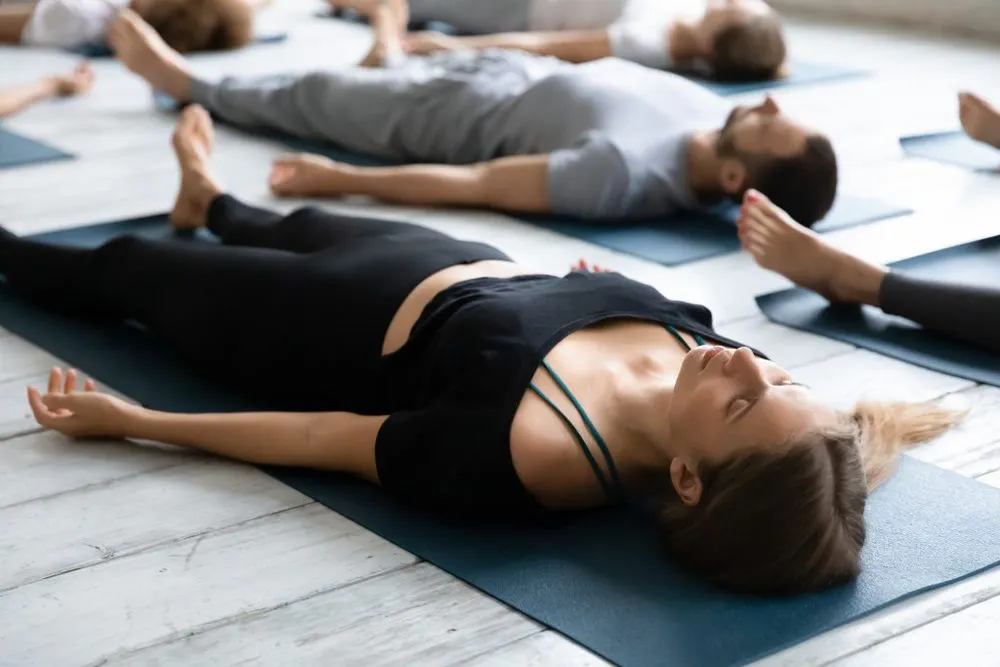In the relentless pace of modern life, stress management techniques have become essential tools to navigate life’s challenges. The quest for a balanced and harmonious life is within reach, and this guide serves as your roadmap. Dive into a diverse array of stress management techniques, from mindfulness practices and outdoor activities to nutrition and holistic well-being strategies. Let’s embark on a journey together to uncover effective tools that will not only help you manage stress but also enhance your overall quality of life.
Mindfulness Meditation
In today’s fast-paced world, stress is an ever-present companion. One powerful and accessible technique for managing stress is mindfulness meditation. In this section, we’ll explore what mindfulness meditation is, its benefits, and how you can easily incorporate it into your daily routine.
What is Mindfulness Meditation?
Mindfulness meditation is a practice rooted in ancient traditions, particularly within Buddhism. It involves paying intentional attention to the present moment without judgment. The core idea is to cultivate awareness of your thoughts, feelings, and surroundings.
Benefits of Mindfulness Meditation for Stress Management
- Reduced Cortisol Levels: Mindfulness meditation has been linked to lower cortisol levels, the hormone associated with stress.
- Enhanced Emotional Well-Being: Regular practice can improve mood and decrease symptoms of anxiety and depression.
- Improved Focus and Concentration: Mindfulness helps train the mind to focus on the present, enhancing cognitive abilities.

How to Practice Mindfulness Meditation
- Find a Quiet Space: Choose a quiet place where you won’t be disturbed.
- Comfortable Posture: Sit or lie down comfortably. You can use a cushion or chair for support.
- Focus on Your Breath: Close your eyes and bring your attention to your breath. Notice the inhalation and exhalation without trying to change it.
- Be Present: As your mind wanders (which is natural), gently guide your focus back to your breath or a chosen point of attention.
- Start with Short Sessions: Begin with 5–10 minutes and gradually extend the duration as you become more comfortable.
Incorporating Mindfulness into Daily Life
Mindfulness isn’t limited to formal meditation sessions. You can infuse it into your daily activities.
- Mindful Eating: Pay full attention to each bite during meals.
- Mindful Walking: Be present during your walks, focusing on the sensation of each step.
- Mindful Breathing Breaks: Take short breaks during the day to focus on a few mindful breaths.
Deep Breathing Exercises
In the pursuit of stress management, one of the simplest yet most effective techniques is deep breathing. Let’s delve into the world of deep breathing exercises, exploring their benefits, how to practice them, and ways to seamlessly integrate them into your daily routine.
Benefits of Deep Breathing for Stress Management
- Calming the Nervous System: Deep breathing triggers the relaxation response, calming the sympathetic nervous system responsible for the “fight or flight” response.
- Reduced Cortisol Levels: Practicing deep breathing has been associated with lower cortisol levels, helping to alleviate stress.
- Improved Oxygenation: Deep breaths increase oxygen intake, promoting better blood flow and enhancing overall well-being.

How to Practice Deep Breathing
- Diaphragmatic Breathing (Belly Breathing):
- Sit or lie down comfortably.
- Place one hand on your chest and the other on your abdomen.
- Inhale slowly through your nose, letting your abdomen rise.
- Exhale through pursed lips, feeling your abdomen fall.
- 4-7-8 Breathing Technique:
- Inhale quietly through your nose for a count of 4.
- Hold your breath for a count of 7.
- Exhale completely through your mouth for a count of 8.
- Box Breathing (Square Breathing):
- Inhale for a count of 4.
- Hold your breath for a count of 4.
- Exhale for a count of 4.
- Pause before inhaling again.
Incorporating Deep Breathing into Daily Life
- Morning Routine: Start your day with a few minutes of deep breathing to set a positive tone.
- Stressful Situations: Practice deep breathing during moments of stress or anxiety to regain composure.
- Before Sleep: Wind down with deep breathing exercises to promote relaxation before bedtime.
Progressive Muscle Relaxation (PMR)
When it comes to stress management, Progressive Muscle Relaxation (PMR) stands out as a highly effective technique. In this section, we’ll explore what PMR is, its benefits, and how you can seamlessly integrate it into your routine to experience a profound sense of relaxation.
What is Progressive Muscle Relaxation (PMR)?
Progressive Muscle Relaxation is a systematic technique developed to alleviate muscle tension. It involves progressively tensing and then releasing different muscle groups, promoting physical and mental relaxation.
Benefits of Progressive Muscle Relaxation for Stress Management
- Reduced Muscle Tension: PMR targets and releases tension in specific muscle groups, promoting overall relaxation.
- Enhanced Mind-Body Awareness: The practice cultivates awareness of the connection between physical tension and mental stress.
- Improved Sleep Quality: Regular PMR sessions are linked to better sleep, as the relaxation response prepares the body for rest.

How to Practice Progressive Muscle Relaxation
- Find a Quiet Space: Choose a comfortable and quiet environment to practice PMR.
- Begin with Deep Breathing: Inhale deeply through your nose and exhale slowly through your mouth to initiate relaxation.
- Systematic Muscle Tension and Release:
- Start with your toes, tensing them for a few seconds, then releasing.
- Gradually work your way up the body, tensing and releasing each muscle group.
- Maintain Awareness: Pay attention to the sensations of tension and relaxation in each muscle group.
- End with Deep Breaths: Conclude the session with a few deep breaths to further enhance relaxation.
Incorporating PMR into Daily Life
- Before Sleep: Practice PMR in bed to unwind and prepare for a restful night’s sleep.
- Midday Breaks: Take short PMR breaks during the day to alleviate accumulated tension.
- Stressful Moments: Use PMR as a tool to regain composure during stressful situations.
Exercise and Physical Activity
In the quest for effective stress management, the role of exercise and physical activity cannot be overstated. This section explores the myriad benefits of incorporating regular exercise into your routine and how it serves as a powerful tool for combating stress.
The Stress-Busting Benefits of Exercise
- Release of Endorphins: Exercise triggers the release of endorphins, the body’s natural mood lifters, promoting a sense of well-being.
- Reduction of Cortisol Levels: Physical activity helps regulate cortisol levels, preventing the adverse effects of chronic stress.
- Improved Sleep Quality: Regular exercise is linked to better sleep patterns, contributing to overall stress reduction.

Types of Exercises for Stress Management
- Aerobic Exercises:
- Activities like jogging, brisk walking, or cycling elevate the heart rate, promoting cardiovascular health and stress relief.
- Strength Training:
- Resistance exercises enhance muscle strength and endurance, contributing to a sense of empowerment and stress resilience.
- Yoga and Pilates:
- Combining physical postures with mindful breathing, yoga and Pilates offer a holistic approach to stress management.
How to Incorporate Exercise into Your Routine
- Set Realistic Goals: Start with achievable fitness goals that align with your current fitness level.
- Find Enjoyable Activities: Choose exercises you enjoy to make physical activity a sustainable and enjoyable part of your routine.
- Schedule Regular Sessions: Consistency is key. Schedule regular exercise sessions, treating them as non-negotiable appointments.
Incorporating Physical Activity into Daily Life
- Active Commuting: Opt for walking or cycling for short commutes to integrate physical activity into your daily routine.
- Desk Exercises: Incorporate simple stretches and exercises into your workday to combat the effects of prolonged sitting.
- Group Activities: Engage in group sports or fitness classes to combine physical activity with social interaction.
Cognitive Behavioral Therapy (CBT) Techniques
When it comes to tackling stress at its roots, Cognitive Behavioral Therapy (CBT) techniques stand out as powerful tools for reshaping thought patterns and behaviors. This section delves into what CBT is, its benefits, and practical techniques you can implement for effective stress management.
Understanding Cognitive Behavioral Therapy (CBT)
Cognitive Behavioral Therapy is a widely used therapeutic approach that focuses on identifying and challenging negative thought patterns and behaviors. By altering these patterns, CBT aims to foster positive mental well-being and resilience.
Benefits of CBT for Stress Management
- Identifying Negative Thought Patterns: CBT helps individuals recognize and reframe distorted or unhelpful thoughts that contribute to stress.
- Behavioral Modification: It addresses unhealthy behaviors by promoting positive changes through goal-setting and gradual exposure.
- Developing Coping Strategies: CBT equips individuals with practical coping strategies to navigate stressful situations more effectively.

Practical CBT Techniques for Stress Relief
- Thought Records:
- Keep a journal to record stressful thoughts.
- Identify and challenge irrational or negative beliefs.
- Replace them with more balanced and realistic thoughts.
- Behavioral Activation:
- Increase engagement in positive activities to counteract the impact of stress.
- Create a schedule that includes enjoyable and fulfilling activities.
- Mindfulness and Relaxation Techniques:
- Integrate mindfulness practices to stay present and manage stress in the moment.
- Use relaxation exercises, such as deep breathing, to calm the mind.
Implementing CBT Techniques in Daily Life
- Daily Reflection: Set aside time each day for self-reflection, using CBT techniques to analyze and reframe stress-inducing thoughts.
- Gradual Exposure: Gradually confront and desensitize yourself to stressors, building resilience over time.
- Goal Setting: Establish realistic and achievable goals, breaking them down into manageable steps to reduce feelings of overwhelm.
Aromatherapy and Essential Oils
Amid the hustle and bustle of life, finding moments of tranquility can be a game-changer for stress management. Enter aromatherapy and essential oils, a delightful journey into the world of scents that can positively impact your mood and overall well-being. In this section, we’ll explore the benefits and practical applications of aromatherapy.
Understanding Aromatherapy and Essential Oils
Aromatherapy is a holistic healing practice that utilizes the aroma of essential oils to promote physical and mental well-being. Essential oils are concentrated plant extracts, each possessing unique properties that contribute to various health benefits.
Benefits of Aromatherapy for Stress Relief
- Calming Effects: Certain scents, such as lavender and chamomile, are known for their calming and soothing properties, helping to alleviate stress.
- Mood Enhancement: Citrus oils like lemon and orange can uplift the mood and promote a positive atmosphere, reducing feelings of anxiety.
- Improved Sleep Quality: Lavender, in particular, is renowned for its sleep-inducing properties, aiding in relaxation and promoting better sleep.

Practical Applications of Aromatherapy
- Diffusers and Vaporizers:
- Add a few drops of your favorite essential oil to a diffuser or vaporizer for a continuous release of fragrance in your living or work space.
- Massage and Topical Application:
- Mix essential oils with a carrier oil for a calming massage or apply a diluted solution to pulse points for on-the-go stress relief.
- Aromatherapy Inhalers:
- Portable inhalers infused with essential oils allow for discreet and convenient use, ideal for stress management in various settings.
Incorporating Aromatherapy into Daily Life
- Bedtime Rituals: Use calming scents like lavender or chamomile before bedtime to create a relaxing atmosphere for improved sleep.
- Workplace Wellness: Diffuse energizing scents like peppermint or eucalyptus in your workspace to enhance focus and reduce stress during the workday.
- Self-Care Moments: Integrate aromatherapy into self-care routines, such as baths or meditation, for an enhanced sense of relaxation.
Time Management Strategies
In the fast-paced rhythm of modern life, effective time management emerges as a crucial skill for maintaining balance and reducing stress. This section will explore practical time management strategies that empower you to make the most of your time while minimizing stressors.
Understanding Time Management
Time management is the art of organizing and prioritizing tasks to make efficient use of your available time. By employing effective strategies, you can enhance productivity, reduce procrastination, and ultimately alleviate stress associated with time-related pressures.

Time Management Strategies for Stress Reduction
- Prioritization and To-Do Lists:
- Identify high-priority tasks and create a to-do list to stay organized and focused.
- Break down larger tasks into smaller, more manageable steps.
- Time Blocking:
- Allocate specific blocks of time for different activities, helping to maintain focus and prevent multitasking.
- The Pomodoro Technique:
- Work in short, focused bursts (typically 25 minutes) followed by a brief break to maintain concentration and avoid burnout.
Utilizing Technology for Time Management
- Calendar Apps:
- Utilize calendar apps to schedule appointments, set reminders, and keep track of deadlines.
- Task Management Apps:
- Explore task management apps to create digital to-do lists, set priorities, and track progress.
- Time Tracking Tools:
- Use time-tracking tools to gain insights into how you spend your time and identify areas for improvement.
Incorporating Time Management into Daily Life
- Morning Planning Routine:
- Begin each day with a brief planning session to outline priorities and set the tone for a productive day.
- Batching Similar Tasks:
- Group similar tasks together to maximize efficiency and minimize context-switching.
- Learn to Say No:
- Recognize your limits and be selective about taking on additional commitments to avoid overwhelm.
Healthy Sleep Habits
Quality sleep is the cornerstone of overall well-being, and establishing healthy sleep habits is paramount for stress management. In this section, we’ll explore practical strategies to enhance the quality of your sleep, ensuring you wake up refreshed and ready to face the day.
Understanding Healthy Sleep Habits
Healthy sleep habits, also known as sleep hygiene, encompass practices and routines that contribute to a restful and rejuvenating night’s sleep. By prioritizing good sleep hygiene, you can mitigate stress, improve mood, and boost overall cognitive function.

Key Healthy Sleep Habits for Stress Reduction
- Consistent Sleep Schedule:
- Aim for a consistent sleep and wake time every day, even on weekends.
- Regularity reinforces your body’s natural circadian rhythm, promoting better sleep quality.
- Create a Relaxing Bedtime Routine:
- Establish a calming pre-sleep routine, incorporating activities such as reading or gentle stretching.
- Avoid stimulating activities, such as watching intense TV shows, right before bedtime.
- Optimize Your Sleep Environment:
- Keep your bedroom cool, dark, and quiet to create an optimal sleep environment.
- Invest in a comfortable mattress and pillows for proper support.
Healthy Sleep Practices Throughout the Day
- Limit Caffeine and Screen Time:
- Reduce caffeine intake, especially in the hours leading up to bedtime.
- Minimize screen time before sleep, as the blue light emitted by devices can interfere with melatonin production.
- Regular Exercise:
- Engage in regular physical activity, but avoid vigorous exercise close to bedtime.
- Physical activity contributes to overall well-being and can enhance sleep quality.
- Mindfulness and Relaxation Techniques:
- Practice mindfulness or relaxation exercises to calm the mind before bedtime.
- Deep breathing, meditation, or gentle yoga can be effective tools.
Incorporating Healthy Sleep Habits into Daily Life
- Digital Detox Before Bed:
- Implement a “digital detox” an hour before bedtime, reducing exposure to screens and promoting relaxation.
- Create a Sleep-Inducing Atmosphere:
- Use calming scents such as lavender through aromatherapy to signal the body that it’s time to wind down.
- Evaluate and Adjust:
- Regularly assess your sleep habits and adjust as needed based on their effectiveness.
Social Support and Connection
In the realm of stress management, the power of social support and connection cannot be overstated. This section delves into the crucial role that strong social ties play in mitigating stress, fostering emotional well-being, and enhancing overall resilience.
Understanding Social Support and Connection
Social support encompasses the network of relationships, be it friends, family, or colleagues, that provide emotional, informational, and practical assistance during challenging times. Building and nurturing these connections is a cornerstone of effective stress management.

Benefits of Social Support for Stress Reduction
- Emotional Support:
- Having a reliable network to share your feelings and experiences with can alleviate emotional distress during stressful periods.
- Practical Assistance:
- Friends and family can offer practical help, whether it’s through sharing responsibilities or providing resources, easing the burden of stressors.
- Enhanced Coping Skills:
- Social connections contribute to the development of effective coping mechanisms, making it easier to navigate challenging situations.
Building and Strengthening Social Connections
- Prioritize Quality Over Quantity:
- Focus on cultivating deep, meaningful connections rather than a large number of superficial relationships.
- Effective Communication:
- Open and honest communication is key to fostering strong connections. Expressing your needs and actively listening to others creates a foundation of trust.
- Shared Activities:
- Engage in shared activities or hobbies with others to strengthen bonds and create shared positive experiences.
The Role of Social Support in Daily Life
- Regular Check-Ins:
- Schedule regular check-ins with friends or family members, whether through phone calls, video chats, or in-person visits.
- Join Social Groups:
- Participate in clubs, classes, or community groups aligned with your interests to expand your social circle.
- Be Present in Times of Need:
- Actively offer support to others during challenging times, reinforcing the reciprocal nature of social connections.
Nutrition for Stress Relief
In the pursuit of stress management, the impact of nutrition should not be underestimated. This section explores the vital connection between what we eat and our ability to cope with stress. Discover how making mindful dietary choices can contribute to a healthier, more resilient mind and body.
Understanding Nutrition for Stress Relief
Nutrition plays a crucial role in our overall well-being, influencing both physical and mental health. The foods we consume can either contribute to stress or serve as powerful allies in stress relief, making mindful choices a key component of an effective stress management strategy.

Stress-Busting Nutrients
- Omega-3 Fatty Acids:
- Found in fatty fish, flaxseeds, and walnuts, omega-3s have been linked to reduced stress and anxiety.
- Complex Carbohydrates:
- Whole grains, fruits, and vegetables provide a steady release of energy, stabilizing blood sugar levels and promoting a balanced mood.
- Antioxidant-Rich Foods:
- Berries, dark chocolate, and colorful fruits and vegetables contain antioxidants that combat oxidative stress associated with chronic stress.
Foods to Limit or Avoid
- Caffeine and Sugar:
- High consumption of caffeine and sugary foods can contribute to increased feelings of anxiety and disrupt sleep patterns.
- Processed Foods:
- Processed and refined foods may lead to energy crashes and negatively impact mood and overall well-being.
- Alcohol:
- While moderate alcohol consumption may be acceptable for some, excessive intake can exacerbate stress and contribute to mental health issues.
Practical Dietary Strategies for Stress Management
- Balanced Meals:
- Prioritize balanced meals containing a mix of lean proteins, whole grains, and plenty of fruits and vegetables.
- Hydration:
- Ensure adequate water intake, as dehydration can affect mood, energy levels, and cognitive function.
- Mindful Eating:
- Practice mindful eating, savoring each bite and paying attention to hunger and fullness cues.
Check Out the Related Article: Unrivaled! The Comprehensive Keto Meal Plan Review for 2023
Technology and Stress
As technology becomes an integral part of our daily lives, it brings both convenience and challenges. This section explores the impact of technology on stress levels and provides practical tips for maintaining a healthy relationship with digital devices.
Understanding the Connection Between Technology and Stress
Technology has revolutionized the way we live and work, but it also introduces potential stressors. Constant connectivity, information overload, and the pressure to stay digitally engaged can contribute to heightened stress levels if not managed effectively.

Common Stressors Associated with Technology
- Information Overload:
- Continuous exposure to vast amounts of information can lead to overwhelm and cognitive fatigue.
- Social Media Comparison:
- Comparing oneself to curated online images can foster feelings of inadequacy and contribute to stress.
- Digital Overload and Burnout:
- The constant barrage of notifications and the expectation of immediate responses can lead to burnout.
Technology Management Strategies for Stress Reduction
- Set Boundaries:
- Establish specific time limits for screen use, especially during leisure time.
- Designate tech-free zones in your home to create spaces for relaxation.
- Digital Detox Periods:
- Schedule regular breaks from technology, allowing yourself to disconnect and recharge.
- Mindful Tech Use:
- Practice mindful technology use by focusing on one task at a time and avoiding multitasking.
Cultivating a Healthy Relationship with Technology
- Social Media Awareness:
- Be mindful of your emotions while using social media, and consider taking breaks when needed.
- Tech-Free Sleep Routine:
- Create a technology-free bedtime routine to promote better sleep quality.
- Utilize Stress-Reducing Apps:
- Explore mindfulness and relaxation apps that can assist in managing stress levels.
Nature and Outdoor Activities
In the midst of hectic daily lives, reconnecting with nature proves to be a powerful antidote to stress. This section explores the restorative benefits of nature and outdoor activities, shedding light on how immersing oneself in natural environments can foster relaxation and well-being.

Understanding the Impact of Nature on Stress
Nature has a unique ability to soothe the mind and alleviate stress. The Japanese practice of “forest bathing” or shinrin-yoku, for example, highlights the therapeutic effects of immersing oneself in natural surroundings. The greenery, fresh air, and calming sounds of nature can have profound effects on our mental and emotional well-being.
Stress-Relieving Benefits of Outdoor Activities
- Reduced Cortisol Levels:
- Time spent outdoors has been linked to lower cortisol levels, the hormone associated with stress.
- Improved Mood and Mental Health:
- Nature walks, hiking, or simply spending time in green spaces can enhance mood and reduce symptoms of anxiety and depression.
- Enhanced Cognitive Function:
- Exposure to nature is associated with improved cognitive function, attention, and creativity.
Incorporating Outdoor Activities for Stress Management
- Nature Walks and Hiking:
- Schedule regular nature walks or hiking trips to reap the physical and mental benefits of outdoor activities.
- Gardening and Green Spaces:
- Cultivate a garden or spend time in green spaces, whether it’s a local park or your backyard.
- Mindful Outdoor Practices:
- Engage in mindfulness activities outdoors, such as meditation, yoga, or simply sitting and observing nature.
Nature-Inspired Stress Reduction Tips
- Unplug and Immerse:
- Take a break from screens and immerse yourself fully in the sights and sounds of nature.
- Seasonal Enjoyment:
- Embrace outdoor activities that align with the seasons, whether it’s skiing in the winter or swimming in the summer.
- Socialize in Nature:
- Combine socializing with outdoor activities by organizing picnics, group hikes, or nature outings with friends.
Mind-Body Practices (Yoga, Tai Chi, etc.)
Mind-body practices, encompassing activities like yoga and Tai Chi, offer a holistic approach to stress management. This section explores the benefits of these practices and how they cultivate a harmonious connection between the mind and body for enhanced well-being.
Understanding Mind-Body Practices
Mind-body practices focus on the integration of physical movement, breath control, and mindfulness to promote overall health and balance. These practices emphasize the connection between mental and physical well-being, providing a powerful tool for stress relief.

Benefits of Mind-Body Practices for Stress Relief
- Stress Reduction Through Mindfulness:
- Mind-body practices encourage present-moment awareness, helping to alleviate stress and anxiety.
- Improved Physical Health:
- Regular engagement in activities like yoga and Tai Chi is associated with improved flexibility, balance, and cardiovascular health.
- Enhanced Emotional Well-Being:
- These practices often incorporate elements of meditation and breathwork, fostering emotional resilience and a calm state of mind.
Popular Mind-Body Practices
- Yoga:
- Combining physical postures, breath control, and meditation, yoga offers a versatile approach to stress relief.
- Tai Chi:
- This Chinese martial art involves slow, deliberate movements, promoting balance, flexibility, and relaxation.
- Meditation:
- Mindful meditation involves focused attention on the breath or a particular thought, promoting mental clarity and stress reduction.
Incorporating Mind-Body Practices into Daily Life
- Start with Short Sessions:
- Begin with short sessions and gradually increase the duration to make these practices accessible and sustainable.
- Mindful Breathing Breaks:
- Incorporate short mindful breathing breaks throughout the day to manage stress in real-time.
- Join Classes or Use Online Resources:
- Explore local classes or use online resources to guide your practice and enhance your mind-body connection.
Conclusion
In the hustle of daily life, stress is inevitable, but with the right strategies, you can not only manage it but thrive. This guide has explored a variety of effective stress management techniques—mindfulness, outdoor activities, nutrition, and more.
As you navigate your stress relief journey, consider integrating practices that resonate with your lifestyle. Whether it’s morning meditation, a nature walk, or a yoga session, the key is to tailor these techniques to suit you.
Remember, balance is holistic. Nourish your body, prioritize sleep, and build meaningful connections. Embrace the outdoors, unplug when needed, and engage in activities that bring joy. By adopting these practices, you’re creating a foundation for a healthier, more resilient you.
In your pursuit of balance, allow yourself the flexibility to explore, adapt, and evolve. Stress management is an ongoing process, so observe the positive shifts in your well-being as you integrate these techniques. May this guide be your companion on the journey to a life rich in balance, tranquility, and enduring resilience.






